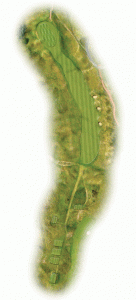
After playing on one of the fairest courses in the rotation for the Open Championship last year (Muirfield), the 2014 British Open tees off today at Royal Liverpool Golf Club, Hoylake, maybe the fairest links course across the Atlantic. The winner the last time the Open Championship was held in Liverpool in 2006, Tiger Woods, posted the joint lowest Open Championship score ever of 270 (18 under par), while six other golfers posted a score of at least 10 under par. Eight years on, and the members of the Royal & Ancient (the governing body that organizes the Open Championship) and Royal Liverpool Golf Club have “fine-tuned” the course with a few devious – some even nefarious – changes to help make sure the extremely low scores posted in 2006 are not duplicated. Besides, it wouldn’t be a British Open without being fraught with perils at every turn, now would it?
On Wednesday, on the eve of the tournament, A Lot Of Sports Talk spoke directly with Andy Cross, member of the championship committee at the Royal Liverpool Golf Club and the public relations and media convenor (manager) there, to talk about some of the critical holes that will determine who will come away with the Claret Jug in 2014. A member of the golf club for almost 40 years, including being club president and being responsible for handing over the Claret Jug to Tiger in 2006, his intimate relationship with the course makes him the go-to person to talk to about how to safely navigate this course, as well as what player tendencies will be while playing a round of golf at Hoylake. With that, Cross gives us the 411 on some of the holes that will provide momentum swings either way. (Click on thumbnails to enlarge images.)
 1st Hole: “It’s how you start…”
1st Hole: “It’s how you start…”
Par: 4; Distance: 458 yards
Andy Cross: If you don’t start well here, it’s going to be hard to recover in a round. It’s probably, in my view, the hardest opening hole in the Open Championship golf rota (rotation). There is a narrow entrance in between two sets of bunkers on right and left. A lot of players will think about playing it short, but the problem is it is normally into the prevailing wind. It plays very long.
The second part of it is that the green was rebuilt in 2010, and we changed it quite a bit from 2006. It’s relatively long and narrow, with three nasty greenside bunkers. And when I say nasty bunkers, even for Hoylake’s standards, I mean nasty. The green has run-off areas to the right and left. Hitting the green with a longer shot is difficult because there’s a little ridge/rise just a little bit shy (10 yards) of the green, which, if you hit, makes it a little unpredictable as to whether you can run the ball on to the green or not.
18th Hole: “…and how you finish.”
Par: 5; Distance: 551 yards
Cross: The four par-5s will be a big factor. (Tiger cleaned up on the par-5s, going a combined 14-under on them throughout the tournament in 2006.) This is a risk and reward par-5, though. It has a couple of great features. The first of these is an out-of-bounds area. There’s low 18-inch wall (called a “cops”) that runs down the right-hand side and juts out towards the fairway. A lot of your trip from tee to green in a straight line would be over the out-of-bounds area. A good drive will take you nearly out of bounds, but, depending on where it’s put, you’re going to have to travel a lot of your second shot over the out-of-bounds area. I don’t care how cool or good you are; if in a tight situation on the last hole of the Open, if you have to move that ball over that much out-of-bounds area, it definitely will add a fear factor.

The trouble is, the bailout shot is to take it left, which introduces the second feature of the hole; three very difficult bunkers to the left of the green. That’s a change from 2006, when there was just one huge bunker in place then. The three small bunkers are smaller in capacity, but all are very deep and have larger collection areas. Even a third shot is at risk if you’ve got somewhere between 20-50 yards to come and you, to any extent, have to take on those bunkers. If you have to take it over those bunkers, and the green is running, you’ll find it very difficult to stop your shot on the green.
The final point is that it’s a narrow gap to the green; it’s about 15 yards wide if you’re hitting it from about 200 yards away (assuming you hit it 300 yards down the fairway). You can run up some big numbers. Adam Scott took a double-bogey 7 there in the final round in 2006, which cost him a top-five finish.
Par: 4; Distance: 447 yards
Cross: The fairway slopes from the left to the right as you play it. Anything struck, say, to the middle will tend to run out and may make one of three bunkers on the right. Sometimes, players have tried to take it, therefore, further left, through the rough. But one of the changes to the hole for this year is introduction of “rough ground,” little hills that have been installed in the rough area (think hills that you would see on a moguls skiing course at the Winter Olympics). The rough is upright now, and still fresh, and when it gets wet, it gets particularly difficult. Also, if landing in that area, you could have an uphill or downhill lie on one of those bumps. In short, you want to hit the fairway. The common play this week will be to play it short, and, if necessary, to the right of the bunkers (and not left of them, where a fairly decent shot to the fairway could still roll over into one of the bunkers).
To finish the hole, if you find the fairway, you have a very nice plateau green which you play up to. The tough part of the green is a big, steep fall-off area to the right. If you find bottom of the bank to the right of this hole, the surface of the green is maybe 12-14 feet up above you, and for a shorter player, it plays even steeper. It played the hardest hole in 2006 (138 bogeys, 15 double bogeys), and it’s even harder now with the moguls installed.
14th Hole: “Over the hill”
Par: 4; Distance: 454 yards
Cross: This has a similar dogleg like the 12th, but has some different features. The tee is well above the fairway, so you have a good view of the fairway. But there are two deep bunkers on the left, and to the left of that, thick, impenetrable gorse bushes. On the other side, you have a couple of bunkers, and then beyond that, some more of that rough ground, the mogully hills that also feature on the 12th. Just in case the fairway is dry and running, you can end up there if you kind of run through the fairway.

The best feature of this hole is up by the green, just in front of it, where there is a little hillock embedded. About half of the green (or more), depending on where you’re playing your approach shot from, is hidden by this hill. Sometimes, players don’t realize there’s a bit more space on the green behind the hill than they might think. Players tend to, therefore, play their approach shot more to the right-hand side of the green, which brings into play the right-hand fall-off area of the green. This fall-off area isn’t as steep as the 12th, but if you do find it, it still will make for a difficult up-and-down. In this instance, you have two options: either putt up that steep, steep bank (which is perfectly acceptable, since putting a long way off the green is common with links golf) or try to chip it into the bank with a straight-faced club and run it up that way (another classic shot in links golf). The hillock makes you think you need to play the shot further right than you really need to, when you actually need to play the shot over the side of the hill. Visually, it’s a very pretty hole and many people think it’s the best hole on the course.
**Graphics courtesy of the Royal Liverpool Golf Club website and pictures courtesy from the Open Championship web site. You can also go to The Open Championship Course Guide Page for detailed images and a brief breakdown on every hole at Royal Liverpool.





